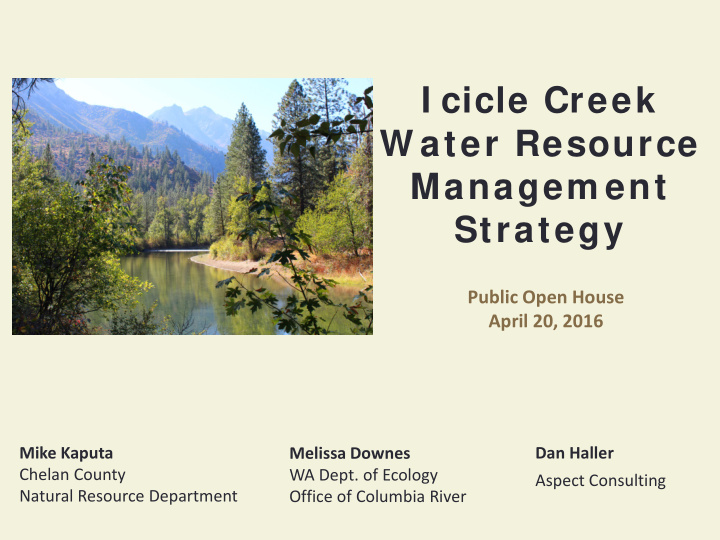



I cicle Creek W ater Resource Managem ent Strategy Public Open House April 20, 2016 Mike Kaputa Dan Haller Melissa Downes Chelan County WA Dept. of Ecology Aspect Consulting Natural Resource Department Office of Columbia River
I cicle W ork Group ( I W G) Background Co-Conveners: Ecology OCR and Chelan County DNR Process: Assembled Icicle Workgroup Stakeholders Timeline: Substantial progress on reaching consensus goals and initiating project evaluations since December 2012 Goals: Meet instream and out-of-stream objectives in Icicle Creek Basin, provide an alternate pathway for conflict resolution other than litigation
I W G Mem bers Office of Columbia River Icicle & Peshastin Irrigation District WA Water Trust Chelan Co Board of Commissioners USFWS – Leavenworth Fish US Forest Service Hatchery Conf Tribes of the Yakama Indian Trout Unlimited City of Leavenworth Nation Agricultural Representative Mel WA State Dept of Fish & Wildlife NOAA Fisheries Weythman Conf Tribes of the Colville Chelan County Agricultural Representative Reservation Daryl Harnden Cascade Orchard Irrigation Co WA State Dept of Ecology City of Cashmere Wild Fish Conservancy US Bureau of Reclamation Icicle Creek Watershed Council
Purpose The purpose of the Icicle Creek Work Group (“Work Group”) is to develop a comprehensive Icicle Creek Water Resource Management Strategy through a collaborative process that will achieve diverse benefits defined by all of the Guiding Principles below. The Work Group will use best available science to identify and support water management solutions that lead to implementation of high-priority water resource projects within the Icicle Creek drainage.
Guiding Principles Improve Streamflow Dry Year Goal = 60 cfs Average Year Goal = 100 to 250 cfs Improve Sustainability of the Leavenworth National Fish Hatchery Meet fish production requirements Fulfill federally protected Tribal fishing rights Protect and conserve water rights Maximize fish health Minimize fish barriers Protect Tribal and Non-Tribal Harvest
Guiding Principles continued Meet Domestic Water Demand Increase year-round supply by 3-6 cfs (peak) meets demand through 2050 Improve Agricultural Reliability Improve management of existing lake storage Current interruptible water use (2-4 cfs) made firm Improve and Protect Icicle Creek Habitat Stream habitat protection and restoration Improve fish passage Comply with State and Federal Laws and Wilderness Acts Environmental Review and Permitting Update fish screens on diversions
Projects The Icicle Work Group evaluated many alternatives and developed a Base Package of Projects that has the ability to meet all of the guiding principles. The Work Group is evaluating project feasibility and conducting environmental review on these projects. If a project is determined to be fatally flawed, it must be replaced or modified to ensure all guiding principles are met.
SEPA 101 • State Environmental Policy Act • Project vs. non-project (programmatic) • Determination of significance • Scoping for Programmatic Environmental Impact Statement (PEIS)
Icicle Strategy SEPA • Proposal: Guiding Principles and “base package” (see Section 11, page 5) • Scoping: What should be addressed in the PEIS? Alternatives Mitigation measures Impacts Approvals
Timeline • May 11, 2016 comments due on the scope of the PEIS • June 2016: Initiate PEIS development • Summer 2017: Publish PEIS and begin public comment period • Fall 2017: Issue final PEIS and begin project- level environmental review
Alpine Lakes Optimization and Automation Improve management and releases of stored water based on changing conditions to meet needs. Project Benefit • Increased stream flow for fish • Improved reliability and operation of stored water for agriculture and Leavenworth National Fish Hatchery
Irrigation Efficiencies Icicle Peshastin Irrigation District Cascade Orchards Irrigation Company Explore options to improve irrigation delivery and on-farm efficiencies. Projects may include canal piping or lining, point of diversion change, and on-farm efficiency upgrades. Project Benefit • Increased stream flow for fish • Improved irrigation system operation and reliability
Domestic Conservation Implement municipal and rural water efficiency projects such as pipe replacements, meter installation and water use conservation. Project Benefit • Improve domestic supply
Leavenworth National Fish Hatchery Conservation and Water Quality Improvements Implement projects at the LNFH that would offset some of the surface water use and improve access to groundwater. Projects may include a Water Reuse System, Water Effluent Pump Back, and Wellfield Enhancements. Project Benefit • Increased Stream Flow for Fish • Improved access to reliable water for hatchery operations
Eightmile Lake Restoration Rebuild the dam to restore usable storage to the historic and permitted high water mark. Project Benefit • Increased instream flow for fish • Meet domestic water needs for City of Leavenworth and rural areas. • Improved operation of infrastructure and storage reliability.
Habitat Enhancement and Protection Identify and implement stream restoration and protection projects such as riparian plantings, engineered log jams and conservation easements. Project Benefit • Improved stream habitat • Improved ecosystem health
Fish Screen and Fish Passage Improvements Upgrade fish screens on diversions to meet current standards. Improve fish passage by assessing and removing barriers. Project Benefit • Improved fish access to habitat • Decreased fish mortality • Compliance with laws
Tribal Fisheries Protection Ensure that projects and actions do not have negative effects on the Tribal fishery in Icicle Creek. Monitor fishery effectiveness and implement actions to improve fishery. Project Benefit • Protects Tribal Treaty and federally protected harvest rights at all times.
Water Markets and Instream Flow Rule Amendment Create a voluntary water market for irrigation water users. Modify instream flow rule’s interim domestic reservation to final level. Project Benefit • Interruptible water users made firm • Meet domestic water needs through 2050
Timeline • May 11, 2016 comments due on the scope of the PEIS • June 2016: Initiate PEIS development • Summer 2017: Publish PEIS and begin public comment period • Fall 2017: Issue final PEIS and begin project- level environmental review
Questions?
Recommend
More recommend